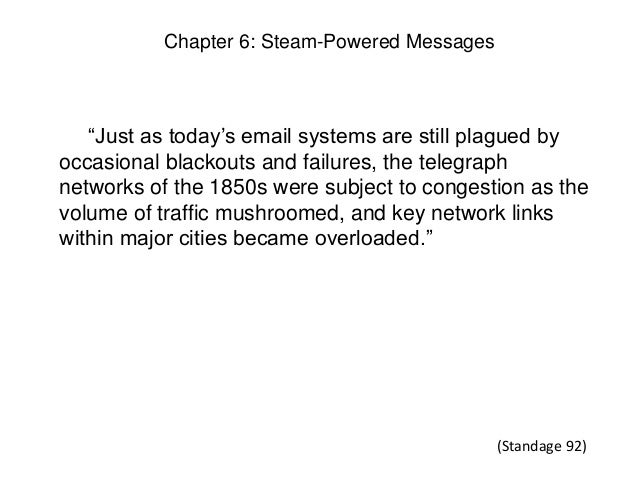Download Free Tom Standage The Victorian Internet Pdf
Read The Victorian Internet PDF - The Remarkable Story of the Telegraph and the Nineteenth Century's On-Line Pioneers by Tom Standage Walker & Co Offers a historical review of the telegraph. In the nineteenth century there were no televisions, aeroplanes, computers, or spacecraft; neither were there antibiotics, credit cards, microwave ovens, compact discs, or mobile phones. There was, however, an Internet. During Queen Victoria's reign, a new communications technology was developed that allowed people to.
We're well beyond the tipping point and find ourselves being flung inexorably into the digital future of self-driving cars (also electric cars), ubiquitous computing, smart assistants, clever household things, online shopping (plus streaming and tweeting), and living full-time in cyberspace with all its challenges and dangers. How did we arrive here?
And what role did Edgar Allan Poe play in its long prehistory? Poe's final years in New York corresponded with the rise of the telegraph, what Tom Standage called The Victorian Internet. The introduction of the telegraph in 1844 led quickly to the creation of a wide communication network that for the first time could transmit information instantaneously to any desired distance, eclipsing the railroad and the steamship, which were only transportation networks for goods and people.
When telegraph relay stations connected local systems, they formed the first network of networks, or internet. By 1848, six New York newspapers had already joined together to form a consortium to share telegraph news, called the Associated Press, giving New York the advantage in becoming the center of national communications.

Only two months after Morse's demonstration of the first practical telegraph in 1844, Poe had already begun writing about it, adding several more discussions in its first year, expressing his excitement not only for its power of distant and instantaneous communication and printing but also, what is astonishing, for its demonstration of the remote control of machines. Poe's final years in New York, 1844–49, were also the years in which the telegraph asserted itself as 'the Victorian internet,' starting the first information revolution, thereafter linking the production of literature to the evolution of media technology. End Page 267 Poe used the terms electric, electro, and magnetic as rough synonyms to necessarily distinguishing it from the older optical telegraph that had used mechanical arms like a semaphore to transmit a visual signal, with the name telegraph originally meaning distance writing. (Such a device had been effectively used by Napoleon for military intelligence in the 1790s.) The early attempts to electrify the telegraph took place when electricity itself was not completely understood, arousing exaggerated hopes and fears that make interesting reading when compared to our sometimes-odd thoughts regarding the Internet today. One early effort in Congress designed to provide support for electrical experiments for the telegraph was conflated with a project to study mesmerism. After its success, the telegraph remained so uncanny to many that it was sometimes regarded up as a representation of spiritualism. More sober contemporaries hoped that the telegraph would standardize communications, raise the levels of cultural and philosophical discourse, and even purify literary style by making it more concise.
Poe's fascination with the possibilities of machine intelligence preceded the invention of the electric telegraph by a decade. After seeing several performances in Richmond of what was claimed to be an intelligent automaton, Poe denounced it as a fraud in 'Maelzel's Chess Player' in the Southern Literary Messenger in April 1836. Johann Nepomuk Maelzel's name is still associated with the metronome; he had previously produced several mechanical devices for the performance of music, one of which was used in a collaboration with Beethoven.
His mechanical chess player, called the Turk, had toured European and American cities as early as 1770. For Poe, who paid several visits to its exhibition, the authenticity of the device was doubtful when measured by his standard, namely, 'the calculating machine of Mr. Babbage,' an early computer that Poe regarded as inherently infallible as a 'pure machine.' However, Maelzel's automaton failed the test: it sometimes lost a game. Poe concluded, 'The Automaton does not invariably win the game. Were the machine a pure machine this would not be the case—it would always win.'
Poe concluded, correctly, that Maelzel's supposed automaton actually required an unseen human assistant. Eight years later, on May 24, 1844, Samuel F. Morse made the landmark public demonstration of the telegraph by sending a famous message from Washington to Baltimore, and Poe was ready to comment on it within two months, publishing a maxim on the character.
This week's theme issue attempts to provide a framework for thinking about the quality of health information on the internet—a source of anxiety almost since its first appearance. Five years ago Impicciatore and colleagues reviewed website advice on managing fever in children and concluded that it varied widely in terms of accuracy, completeness, and consistency. Pick any medical problem today, and the chances are you'll find the same.
With at least 80 studies reporting similar findings (G Eysenbach, personal communication), we need no more convincing that the quality of information on the web varies as widely as it does in other media. In 1997 Gagliardi and Jadad identified 47 instruments for measuring healthcare quality on the internet.
Four years later, they found another 51—all of them unvalidated (p ). Generating yet more unproved instruments looks like another activity that researchers could usefully stop. However, the proliferation of tools for assessing quality continues unabated, fuelled by anxieties about patient harm. As our international roundup shows (pp 566-7), countries now seem poised to get in on the act, although little beyond urban myths exists to justify the level of their concerns. Health information on the internet ranges from personal accounts of illnesses and patient discussion groups to peer reviewed journal articles and clinical decision support tools. Defining a single quality standard for such a disparate collection of resources is challenging.
Furthermore, different users may have different criteria for quality. Patients and caregivers may want simple explanations and reassurance, whereas healthcare professionals may want data from clinical trials. Criteria for determining quality can be organised by their applicability to various dimensions of online health information, such as content, type, and intended audience. For standards pertaining only to content we can use traditional metrics, such as the levels of evidence and strength of recommendations.
The type of information also affects which measures are applicable. Medical knowledge can be evaluated by scientific standards, whereas literary or journalistic criteria may be more appropriate for personal narratives. And the intended audience influences the measures of quality that are applicable to a particular type of content. Consumer health information should be written at a comprehensible reading level; often patients want pragmatic information, such as how long their illness will prevent them from working, before scientific details. Shepperd and Charnock argue against “exceptionalism” for medical information on the internet and support standards of quality that apply across media (p ). While this approach may be appropriate for many aspects of electronic health resources, some features warrant special consideration. The interface to online information can be distinguished from the content, and the criteria for quality of an interface depend on the communication technology used.
Principles for good web design differ from those for creation of high quality handheld applications. Furthermore, our concepts of quality change as the technology evolves. Nielsen's top 10 mistakes in web design remain relevant today (box), but their implications for usability have changed over time.

Download Free Tom Standage The Victorian Internet Pdf Download
Patients who seek online health information may have a variety of physical impairments, and it is important to develop resources that are usable by individuals with disabilities. The Web Accessibility Initiative provides guidelines for assuring broad accessibility to internet based information.
